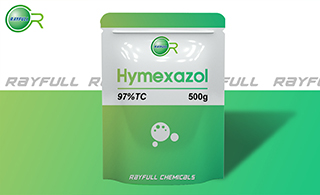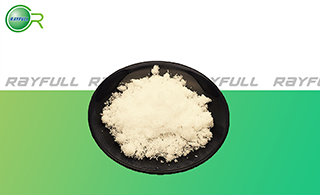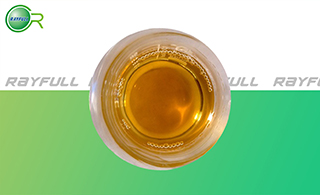Hymexazol
    恶霉灵 恶霉灵
Introduction: Hymexazol is used for controlling of soil-borne diseases caused by Fusarium, Aphanomyces, Pythium, and Corticium spp., etc. in rice, sugar beet, fodder beet, vegetables, cucurbits, ornamentals, carnations, and forest tree seedlings. Applied as a soil drench, or by soil incorporation, and also used as a seed dressing for sugar beet and fodder beet, at 5-90 g/kg seed. Also exhibits some plant growth stimulation activity.
Common name: Hymexazol
Another name: 3-Hydroxy-5-methylisoxazole; Hymexazole; 5-Methylisoxazol-3-ol; 5-methylisoxazol-3(2H)-one; etc.
Chemical name: 5-methylisoxazol-3-ol
Empirical formula: C4H5NO2
Structural formula:

Mol. Weight: 99.15 g/mol
CAS No.: 10004-44-1
Specifications
Leading Hymexazol supplier
Hymexazol 97% TC
Hymexazol 360 g/L SL
Packing:
BULK PACKING
Powder: 25kg/Bag, 25kg/Drum, 50kg/Drum etc.
Liquid: 200L/Drum, 20L/Drum, 10L/Drum etc.
SMALL PACKING
Powder: 1kg/Alu bag, 500g/Alu bag, 200g/Alu bag, 100g/Alu bag, 50g/Alu bag, 15g/Alu bag etc.
Liquid: 5L/Drum, 1L/Bottle, 500ml/Bottle, 250ml/Bottle, 100ml/Bottle, 50ml/Bottle etc.
Customerized packing label
Hymexazol FAO standard
Professional registration
HAZARDS IDENTIFICATION
Hazard statement(s)
H302 (100%): Harmful if swallowed.
H317 (10.84%): May cause an allergic skin reaction.
H318 (98.8%): Causes serious eye damage.
H411 (10.84%): Toxic to aquatic life with long lasting effects.
H412 (87.95%): Harmful to aquatic life with long lasting effects.
Precautionary statement(s)
P261: Avoid breathing dust/fume/gas/mist/vapors/spray.
P264: Wash ... thoroughly after handling.
P270: Do not eat, drink or smoke when using this product.
P273: Avoid release to the environment.
P280: Wear protective gloves/protective clothing/eye protection/face protection.
P301+P312: IF SWALLOWED: call a POISON CENTER/doctor/... IF you feel unwell.
P302+P352: IF ON SKIN: wash with plenty of water.
P305+P351+P338: IF IN EYES: Rinse cautiously with water for several minutes. Remove contact lenses if present and easy to do - continue rinsing.
P310: Immediately call a POISON CENTER or doctor/physician.
P321: Specific treatment (see ... on this label).
P330: Rinse mouth.
P391: Collect spillage.
P501: Dispose of contents/container to an approved waste disposal plant.
Supplemental Hazard Statements: none.
MAMMALIAN TOXICOLOGY
Acute toxicity: 1) Acute oral LD50 for rats is 1600 mg/kg. 2) Acute dermal LD50 for rabbits is >2000 mg/kg. 3) Acute inhalation toxicity LC50 (4 h) for rats is >0.65 mg/L. 4) Skin irritation: Slightly irritating to skin (rabbits). 5) Eye irritation: Severe corneal opacity with hyperaemic blood vessels. 6) Skin sensitization for guinea pig: Sensitising (Magnusson & Kligman method).
NOEL: (2 y) for rats is 99 mg/kg/day; (91 w) for mice is 355 mg/kg/day; (1 y) for dogs is 17 mg/kg/day. Other Not genotoxic.
ADI 0-0.17 mg/kg b.w.
Classification:
WHO Classification: III (Slightly hazardous)
EC Risk Classification: Xn - Harmful: R22, R41; N - Dangerous for the environment: R52, R53
US EPA Classification (formulation): III (Caution - Slightly toxic)
ECOTOXICOLOGY
Effect on birds: Acute oral LD50 for Japanese quail is >1085 mg/kg. Effect on fish: Acute LC50 (96 h) for Rainbow trout is 100 mg/l. Effects on aquatic invertebrates: Acute EC50 (48 h) for Daphnia magna is 28 mg/l. Effects on algae: Acute 72 hour EC50 for Pseudokirchneriella subcapitata is 36 mg/l. Effects on bees: contact acute 48 hour LD50 is >100 μg/bee, oral acute 48 hour LD50 is >100 μg/bee. Effects on earthworms: Acute 14 day LC50 is 281.9 mg/kg.
ENVIRONMENTAL FATE
Animals In mammals, following oral administration, hymexazol is metabolised to glucuronides. Plants In plants, hymexazol undergoes degradation to O- and N- glucosides. Soil/Environment In soil, hymexazol is degraded to 5-methyl-2-(3H) -oxazolone, DT50 2-25 d.
Usage: Hymexazol was introduced by Sankyo Co., Ltd. It is a systemic fungicide used to control soil-borne diseases caused by Fusaruim, Aphanomyces and Pythium spp..
Application: Biochemistry Possible DNA/RNA synthesis inhibitor. Mode of action Systemic soil and seed fungicide. Uses Control of soil-borne diseases caused by Fusarium, Aphanomyces, Pythium, and Corticium spp., etc. in rice, sugar beet, fodder beet, vegetables, cucurbits, ornamentals, carnations, and forest tree seedlings. Applied as a soil drench, at 30-60 g/hl, or by soil incorporation, and also used as a seed dressing for sugar beet and fodder beet, at 5-90 g/kg seed. Also exhibits some plant growth stimulation activity.
| 






